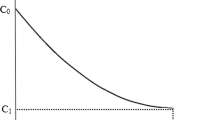Abstract
The dissolution mechanism of rock salt under the effect of gravity was investigated in the laboratory using a dynamic dissolution test apparatus. Rock salt specimens were subjected to dissolution at different flow rates and the weight of the dissolved salt was measured over time and a comparison between the dissolution weight changes under the effect of gravity of this paper and those of dissolution without considering the gravitational effect was analyzed. After introducing the partial differential equations of a dynamic dissolution which conducted in a non-gravity condition, the influence of different parameters on the dissolution model was discussed to establish the dynamic dissolution model of rock salt under gravitational effect. Then, a numerical solution based on the finite-difference method and parameter inversion was conducted, whose numerical calculation results were in good agreement with the experimental results. The results of this paper can provide a basic theoretical foundation and analytical means that can serve a guide for studies on the dissolution mechanism of rock salt.








Similar content being viewed by others
References
Cosenza P, Ghoreychi M, Bazargan-Sabet B, de Marsily G (1999) In situ rock salt permeability measurement for long term safety assessment of storage. Int J Rock Meck Min Sci 36(4):509–526
Hampel A, Schulze O (2007) The composite dilatancy model: a constitutive model for the mechanical behavior of rock salt. In: Wallner M, Lux K-H, minkley W, Hardy H R Jr, (ed). The Mechanical Behavior of Salt-Understanding of THMC Process in Salt, Taylor & Francis Group, 99–107
Jessen FW (1972) Progress report-1)Rate of solution of salt under turbulent flow conditions, 2) study of mixing effects in salt water, 3) Mechanism of solution and cavity control using intermediate injection, 4) Investigation of multiple well system, Solution mining Research Institute file 72-0009-SMRI
Jiang DY, Chen J, Liu JP, Zhou LJ, Wang CR (2009) Experimental research on acoustic and dissolved properties of stress damaged salt rock. Rock Soil Mech 30(12):3569–3573 (In Chinese)
Liang WG, Zhao YS, Xu SG, Dusseault B (2008) Dissolution and seepage coupling effect on transport and mechanical properties of glauberite salt rock. Transp Porous Med 74(2):185–189
Liu CL, Xu LJ, Xian XF (2002) Fractal-like kinetic characteristics of rock salt dissolution in water. Colloid Surf A 201(1–3):231–235
Liu XR, Yang X, Zhong ZL, Liang NH, Wang JB, Huang M (2015) Research on dynamic dissolving model and experiment for rock salt under different flow conditions. Adv Mater Sci Eng. doi:10.1155/2015/959726
Ma HL, Chen F, Yang CH, Shi XL, Zhang M (2010) Experimental research on dissolution rate of salt rock in depth. Min Res Dev 30(5):9–13 (In Chinese)
Ren S, Yang C, Jiang D, Li X, Song S (2011) Development of a new triaxial testing machine with high temperature for dissolution characteristics of salt rock and its application. Chin J Rock Mech Eng 30(2):289–295 (In Chinese)
Stormont JC (1997) In situ gas permeability measurements to delineate damage in rock salt. Int J Rock Meck Min Sci 34(7):1055–1064
Tang YC, Fang JN, Zhou H (2012) Study of rock salt dissolving characteristics test with triaxial stress effect. Rock Soil Mech 33(6):1601–1607 (In Chinese)
Tsang CF, Bemier F, Davies C (2005) Geohydromechanical processes in the excavation damaged zone in crystalline rock, rock salt, and indurated and plastic clays-in the context of radioactive waste disposal. Int J Rock Meck Min Sci 42(1):109–125
Wawersik WR (1981) Creep testing of salt: procedures, problem and suggestions. The First Conference on Mechanical Behaviors of Salt, Trans Tech Publication, 421–429
Yang CH, Jing WJ, Daemen JJK, Zhang GM, Du C (2013) Analysis of major risks associated with hydrocarbon storage caverns in bedded salt rock. Reliab Eng Syst Saf 113:94–111
Zhou H, Tang YC, Hu DW, Feng XT, Shao JF (2006) Study on coupled penetrating-dissolving model and experiment for salt rock cracks. Chin J Rock Mech Eng 25(5):946–950 (In Chinese)
Acknowledgments
This study is supported by the Fundamental Research Funds for Central Universities (Grant No. CDJXS12200005 and Grant No. CDJZR12200003), we gratefully acknowledge these supports.
Author information
Authors and Affiliations
Corresponding author
Rights and permissions
About this article
Cite this article
Liu, X., Yang, X., Wang, J. et al. A dynamic dissolution model of rock salt under gravity for different flow rates. Arab J Geosci 9, 226 (2016). https://doi.org/10.1007/s12517-015-2254-0
Received:
Accepted:
Published:
DOI: https://doi.org/10.1007/s12517-015-2254-0




